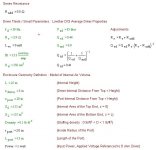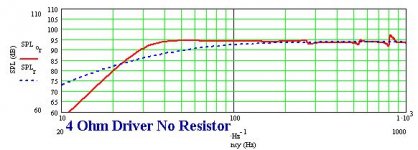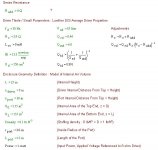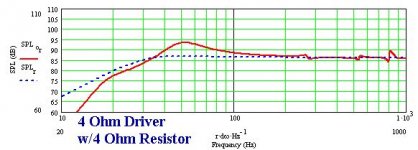I have 4 ohm single voice coil subwoofer. I have a spare amp at home but it can only drive 8ohm speaker. Can i connect a resistor in series with the subwoofer so that it becomes 8ohm load for the amplifier ?
its a kenwood stereo amp with about 40W power 8-16ohms. i am looking for a temporary solution to power my subwoofer.
a 4 ohm resistor is not going to hurt anything as long as it has a high enough power rating. The power rating should be about half of what the amp can deliver. Madisound's 25W Wire-wound resistors are cheap enough ($0.65) that I would get two 8 ohm resistors wire them in parallel to eliminate any risk overheating even with extensive high volume usage. This would allow the resistors to easily withstand the ~80W peak power from the amplifier when wired in series with a 4 ohm driver.
Keep in mind adding a series R will change the frequency response and you will be wasting ~half what the amp is capable of.
If you are using a passive crossover it will also be affected.
If you are using a passive crossover it will also be affected.
I was going to recommend "bridging" your amp so you can drive the sub from both channels, but that won't work here. The sub would either have to be 16 ohms, or your amp channels would have to be able to drive 2 ohm loads. That is not the case here.
Here's the link to the discussion, not that it is going to help you in this application:
http://www.diyaudio.com/forums/showthread.php?threadid=750
As long as this is just temporary, then a 4 ohm resistor is the way to go.
Here's the link to the discussion, not that it is going to help you in this application:
http://www.diyaudio.com/forums/showthread.php?threadid=750
As long as this is just temporary, then a 4 ohm resistor is the way to go.
One more thing. The amp that is going to power your main speakers, not the sub-is that a stero amp or an AV amp?
The reason I am asking is that many AV receivers have a jack in back which carries a bass-only signal to a powered subwoofer. If that is the case, then of course you don't have to worry about a passive crossover for your sub.
The reason I am asking is that many AV receivers have a jack in back which carries a bass-only signal to a powered subwoofer. If that is the case, then of course you don't have to worry about a passive crossover for your sub.
ocool_15 said:Keep in mind adding a series R will change the frequency response and you will be wasting ~half what the amp is capable of.
If you are using a passive crossover it will also be affected.
How will it change the frequency response?
how can you waste amplifier power when it is rated at 8 ohms and it will be seeing 8 ohms, with a 4 ohm driver he'll be most likely fry the amp, that would be wasteful.
Hmmm......
Sticking a 4R resistor in series is a very bad idea, driver Qts will
approximately double, not good at all, boombox will be the result.
A stereo amplifier can be wired in parallel (not bridged). Parallel
the inputs and add to each output 0.22/0.33R series resistors
before they are paralleled together. The resistors will ensure
current sharing and take up any gain / DC offset issues.
Each channel will see an 8ohm load (with a 4ohm load).
🙂/sreten.
Sticking a 4R resistor in series is a very bad idea, driver Qts will
approximately double, not good at all, boombox will be the result.
A stereo amplifier can be wired in parallel (not bridged). Parallel
the inputs and add to each output 0.22/0.33R series resistors
before they are paralleled together. The resistors will ensure
current sharing and take up any gain / DC offset issues.
Each channel will see an 8ohm load (with a 4ohm load).
🙂/sreten.
Sticking a 4R resistor in series is a very bad idea, driver Qts will double
I have heard of this with DVC drivers (resistor across one coil) but how does Qts double from a resistor? It doesn't happen when you wire two woofers in series, or two coils of a DVC sub.
nunayafb said:
How will it change the frequency response?
how can you waste amplifier power when it is rated at 8 ohms and it will be seeing 8 ohms, with a 4 ohm driver he'll be most likely fry the amp, that would be wasteful.
If his amplifier is 40W(assuming per channel) and you have 2 resistors in series of the same resistance they will each disipate half the power. So the speaker would see 20W assuming a fixed impedence.
A speakers impedence varies with frequency. When its impedence is higher the speaker will have more voltage drop across it and therefore more output. Less output when the impedence is low. For the low frequencies note the impedence is also affected by the enclosure. The higher the qtc of a speaker in an enclosure the more the impedence will vary. The least error overall would likely be in a vented enclosure with a lower qts driver.
Look up Joule's Law and Ohm's Law for a better understanding of the reasoning.
Post #9 by sreten is a better solution
Nun:
Illustrations coming up about changes in frequency response due to resistor. Give me an hour or so, this will explain.
Illustrations coming up about changes in frequency response due to resistor. Give me an hour or so, this will explain.
Using Martin J. King's cheapware, available at
www.quarter-wave.com
Here are the parameters for a 12 inch sub, Qtc = 0.41, in a 2.25 cu ft box tuned to 30 Hz. That is a 4 inch diamter, (2 inch radius) tube of 13 inches long. Note the Qts is 0.41 when we do not add a resistor.
Note that with Martin's software, Vad = Vas, and Qtd = Qts. It is just his individual method of labelling.
www.quarter-wave.com
Here are the parameters for a 12 inch sub, Qtc = 0.41, in a 2.25 cu ft box tuned to 30 Hz. That is a 4 inch diamter, (2 inch radius) tube of 13 inches long. Note the Qts is 0.41 when we do not add a resistor.
Note that with Martin's software, Vad = Vas, and Qtd = Qts. It is just his individual method of labelling.
Attachments
Now here is frequency response chart of this woofer, again with no resistor added. Note the sensitivity-this is with 2.8 Volts running through it, which with a 4 ohm speaker is the equivalent of 2 watts.
The red line is tha ported response, the dotted blue line is response of the same size box with no port in it.
The red line is tha ported response, the dotted blue line is response of the same size box with no port in it.
Attachments
Now here is the frequency response graph with the added 4 ohm resistor. Note how the sensitivity drops at 2.8 Volts running through the speaker, except aroudn 50 Hz or so. Part of that is lack of efficiency, part of it is the fact that now the speaker is only getting 1 watt of power at 2.8 Volts-the 4 ohm resistor is absorbing the other watt.
Attachments
initially 2.8*2.8/4= 2W (only 4 ohm speaker)
then you add a resistance of 4 ohm
then 2.8*2.8/(4+4)= 1W , that mean 0.5 watt for the speaker o/p and 0.5 for resistance
2W to 0.5 Watt, right your graph also shows a loss of 6-7 db
then you add a resistance of 4 ohm
then 2.8*2.8/(4+4)= 1W , that mean 0.5 watt for the speaker o/p and 0.5 for resistance
2W to 0.5 Watt, right your graph also shows a loss of 6-7 db
If I understand it correctly, it's a stereo amp then why not just parallel the two channel (not bridging them). Buy a splitter cable, and feed each input with the same signal and connect plus to plus and minus to minus on the outputs.
Then you have a 40W mono amp capable of driving 4 Ohm speakers. Problem solved.
Then you have a 40W mono amp capable of driving 4 Ohm speakers. Problem solved.
Saturnus said:If I understand it correctly, it's a stereo amp then why not just parallel the two channel (not bridging them). Buy a splitter cable, and feed each input with the same signal and connect plus to plus and minus to minus on the outputs.
are you sure we can parallel the 2 channel?
are you sure we can parallel the 2 channel?
any difference in 2 channel can result in problem.
ok on 2nd thought i think it will work, how about taking only 30W o/p instead of 40W to be on a safer side [😛]
- Status
- Not open for further replies.
- Home
- Loudspeakers
- Subwoofers
- Powering Subwoofer



